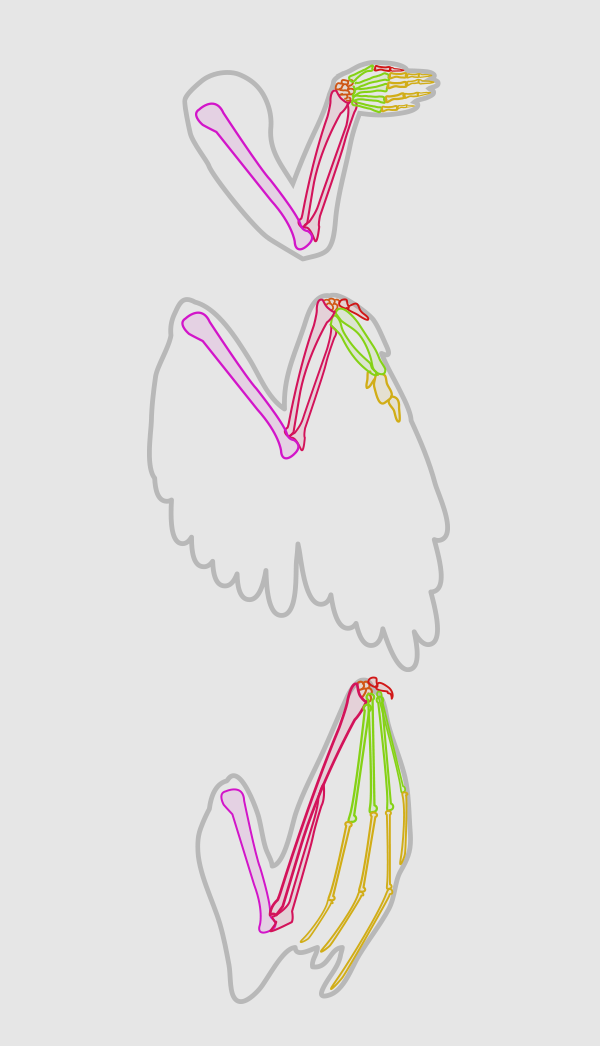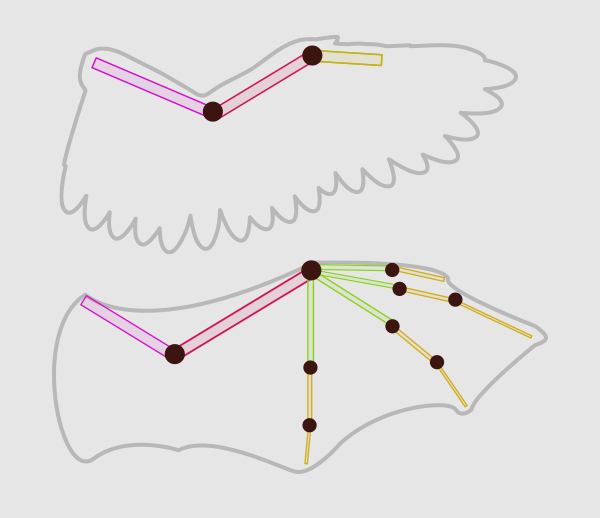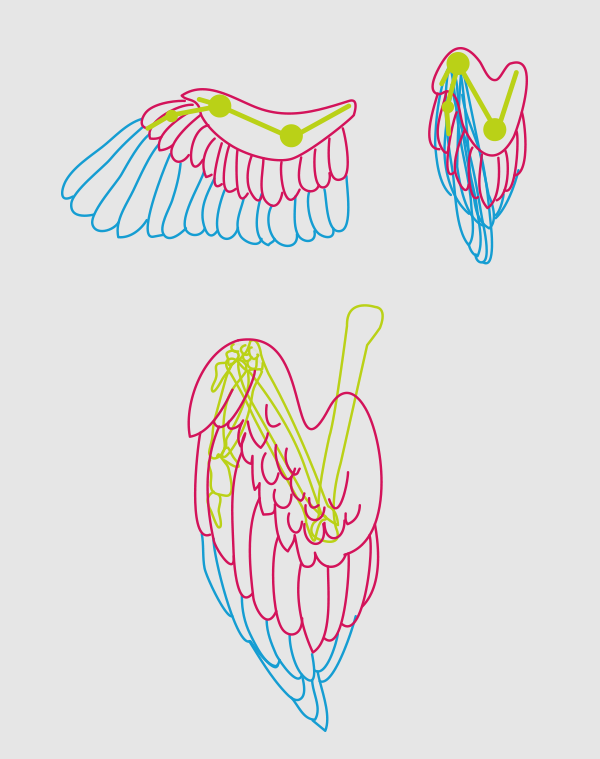Here's the second one as promised. Enjoy and Happy Reading!!!!!
Length:LongLanguages:
This post is part of a series called How to Draw Animals.

There are a few things every artists should be able to draw, with wings being certainly one of them. In this tutorial I'll show you how birds' and dragons' wings are built, why they're built this way and how to create believable poses for them.
1. Basics of Wing Anatomy
Step 1
Wings evolved from the same structure as an arm, so they're quite similar. Just look at the plan below - as you can see, it's mostly the hand structure that makes the difference:
- Birds have most of the hand bones united in simple shapes.
- Bats' fingers are very long, they also start directly on the wrist.
- Both birds and bats use their thumbs for precise maneuvers.

Step 2
When the wing are folded, all of the bones try to come closer to each other.

Step 3
We can simplify the plan of the bones to better understand the way it's working. Also, these basic lines are all you need to start a correct picture of wings!

Step 4
Since wings are so similar to your arm, why don't you use it to find a good pose? Try to flap your arms, spread your fingers - imagine you have feathers of a membrane between them. It will help you understand what poses are natural (therefore, realistic when drawn).

2. The Structure of Feathered Wings
Step 1
The whole bird's arm doesn't build the wing. It actually starts just before the elbow.

Step 2
Have you ever seen featherless chicken's wings? This is the part built of bones, muscles and skin. To build real wings, we need to attach feathers to this naked arm.

Step 3
The feathers have different directions according to the part of arm they're attached to.

Step 4
The first "layer" of feathers you should draw is lesser and median secondary coverts. These are the little scale-like feathers that cover the upper part of the wing. They end with alula - a small cluster of feathers attached to the thumb. You can treat alula just like a bird's thumb for easier understanding.

Step 5
Even when placing these little scaly-feathers you need to remember about right direction. But that's actually the only rule you need to remember at the moment; you can draw them quite chaotically and lightly. There's no need to draw them one by one, they're so small and tightly placed that usually you can't see single feathers.

Step 6
Before we go any further, you need to learn one important rule that usually amateurs are unfamiliar with. A wing has two sides - top and bottom. The feathers overlap each other in a non-random way. From the top view you can see only outer edges of the feathers, from the bottom - only the inner ones.

Step 7
Since you know the rules of direction and overlapping, you can start to draw the primary coverts. Here come two new rules:
- Don't draw the feathers pointy - the ones used for flying are always rounded;
- The closer you are to the joint, the shorter the feathers.

Step 8
This part of a wing is called greater secondary coverts. They're pretty easy to draw.

Step 9
The greater secondary coverts should also be placed behind the elbow point, though they usually start to blend with abdomen/back feathers here.

Step 10
Once you've covered all the arm with feathers, time to attach the most important ones. The "hand" feathers are called primaries. We can see two joints here - on the wrist and where the fingers starts. The feathers attached to the fingers are great for precise maneuvers. Big birds (like eagles) have them slotted. They give them more agility and look awesome, too.

Step 11
The rest of the feathers of this part are attached to the wrist-palm area. They're big and rounded.

Step 12
The secondaries are attached to the forearm. They look just like a bigger copy of greater secondary coverts above them.

Step 13
The tertials are an element blending the wing with the body. When you draw a wing from the top view, draw them as a cluster of long feathers. From the bottom view, they'll be just partially visible and covered by a part of secondaries.

Step 14
That's the fully sketched wing.

3. The Structure of Webbed Wings
Step 1
Bats' wings aren't as complicated as birds', but they're still fascinating. Their arms are very similar to humans', as there's a whole hand of long fingers. All the fingers are connected with each other and the body with a membrane. When bats spread their wings, the membrane is stretching - that's why it doesn't crease so much when the wings are folded.

Step 2
But hey, who really draws bats? They're surely cute, but... let's be honest, it's their wings that interests us. Wings that we can use for our dragons and demons! Bad news is you are not able to draw an anatomically correct dragon wing. Good news is - nobody can! Dragons just don't exist, and if they existed, they could use different mechanics of flight (and probably they wouldn't be able to fly majestically as we imagine them). However, I can give you a bit of advice to draw them as realistically as possible.
First, you'll need strong arm muscles. When the body is well-built, the wings must be equally strong to carry it. You can use human arm anatomy for reference. Also, it's important to give your dragon very big back muscles.

Step 3
When drawing the "finger", it's important to stress the joints. They give a realistic feel and let you attach the membrane correctly.

Step 4
There's one mistake a lot of people do (me too, in the past!). It's probably because a bat's arm isn't as long as a dragon's (at least, as most of us imagine them). When the dragon's arm is bending, we can see a fold under the elbow. Hence the conclusion there's a bone deforming it, just like the bat's foot deforming the membrane of the tail. Putting a bone here doesn't make too much sense, yet a lot of professional artist do it. Apparently, it's not forbidden, but you need to ask yourself if your dragon really needs it!

Step 5
Cover the arm with a membrane. As you can see, the arm - bones and muscles - is placed inside the membrane, not on it. That's why you should blend the fingers into the wing. Also, the membrane should be stretched the most between joints.
When it comes to tears, they look quite realistic (they say wings are used), but they need to be as small as possible - as they would drastically break the lift.

Step 6
Below is how you can do it:

Step 7
A membrane isn't a dead material, it needs to be nourished by blood like every other organ. A web of veins will add a realistic feel to your drawing. Just remember - big blood vessels spread into thin capillaries. They start on the arm, not somewhere at the edge of the wing. If they did, every little tear would lead to serious bleeding!

Step 8
When drawing the veins, keep them light and almost invisible. A nice trick is not to draw all their edges, and stress only some of them.

Step 9
You can also add skin texture to the wings. The easiest one is a wide cross-hatching. Change its density according to the membrane's stretching - the bigger tension, the thinner the texture.

The dragon wing is done!

4. Flight Theory
Step 1
To fully understand how to draw wings realistically in every position you need to first learn how they work and what's the purpose of their shape. Beside the obvious learning benefit, isn't it nice to know how things work?
So, how is it a bird or a bat can fly? Let's start from the beginning of every flight - the take off. Our birdie - let's call him Bob - is sitting on a pole. The little circles around him are the air particles. When there's no wind, they don't move.

Step 2
Bob just spread his wings and jumped into the air! The gravity is dragging him down for a moment, but he has his ways to fight it...

Step 3
Bob uses his strong arm muscles to flap his wings. They're so wide that they move all the air particles on their way under Bob's body.

Step 4
But hey, now there's an empty area over Bob's back, and the particles under his body are squashed! Air particles like balance. They want to be placed evenly in the space, without any vacuum spots. So, our squashed air particles fly up to fill the empty area. And when they do it, they push Bob's body up and forward.

Step 5
But that's not enough to make Bob fly. Flapping just makes him moving fast forward and thus generate wind (air movement) that the bird can use to create more lift.
To put it simply:
- When a bird moves through the air (even falling), there's a lift created under its body - it's pushing it up. The faster the movement, the stronger lift. At the same time, gravity is pulling the bird down.
- As we have noticed, flapping creates lift too.
- Thanks to the special wing's shape, air particles hitting the wing need to fly faster over the wing than under it. Gravity has less time to strike this way.
What do we need lift for:
- When lift is stronger than gravity (weight), bird is pulled up.
- When lift is equal to gravity, bird glides/flies.
- When lift is lower than gravity, bird falls down (and needs to flap - create more lift - to stay aloft).

5. Wings in Motion
Step 1
It's important to know wings don't move just up and down when they're flapping. The only purpose of this action is to push the air down, so the upstroke serves only one point - to get the wings up again for another down stroke. What does it mean?
- During the down stroke wings are wide spread, they try to push as much air as possible.
- During the upstroke wings are slightly folded, and the primaries are separated. They don't come back the same way, they're actually sneaking back not to break freshly created lift.
This will apply to bats/dragons too.

Step 2
You can see the rotation clearer from the back/front. Take a good look at both down stroke and upstroke. Also, notice how air motion changes the shape of primaries' tips.

Step 3
Folding a wing of a bird isn't that hard once you learn one simple rule about it - primaries are overlapped with the rest of the wing while folding. That's all!

Step 4
Folding a webbed wing is a bit more complicated. You need to imagine the areas of tension first. They can look like simple feathers. When the wing is being folded, the feathers are getting closer to each other, overlapping them.
As it was said before, you don't need to add that many wrinkles to the folded membrane. It should be just less smooth than the fully spread wing.

Step 5
Once you know the rules and wing's anatomy, you can draw them in any position using perspective (yep - you won't avoid learning perspective, it's everywhere!). The trick is it's always best to start with bat wing for a pose, as the fingers will help you establish the primaries too.

6. Common Mistakes
There are a few mistakes most of us do at some level. They usually come from ignorance - you think you know how a wing looks, so why wouldn't you draw it?
Step 1
Firstly, a wing's arm cannot be fully expanded. There's a ligament between the wrist and the shoulder, and it can't expand forever. This applies to both birds and bats.

Step 2
Feathers are rounded, not pointed. Big birds like eagles can have slotted feathers in their primaries, but that's the only place they can exist without breaking the lift.

Step 3
Another mistake is drawing all the feathers in the same direction. As we noticed before, it's not how it works! Feathers overlap each other, and they can't overlap both sides at the same time.

Advertisement
Step 4
Dragon fans are not innocent either. The most common mistake here is drawing the wings completely flat (no joints in the fingers) and forgetting about the membrane between the shoulder and the wrist. That membrane is very important for building an aerodynamic shape.

Now You Can Fly!
Now you're a wing expert! You can draw birds, bats, gryffins, angels, dragons and demons with natural, realistic wings. Until next time, happy drawing!
Advertisement

No comments:
Post a Comment